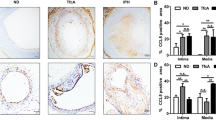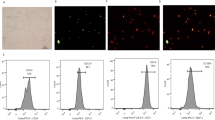Abstract
Circulating endothelial progenitor cells (EPCs) have a critical role in endothelial maintenance and repair. Apolipoprotein A-I mimetic peptide D-4F has been shown to posses anti-atherogenic properties via sequestration of oxidized phospholipids, induction of remodeling of high density lipoprotein and promotion of cholesterol efflux from macrophage-derived foam cells. In this study, we test the effects of D-4F on EPC biology. EPCs were isolated from the peripheral venous blood of healthy male volunteers and characterized by 1,1′-dioctadecyl-3,3,3′,3′-tetramethylindocarbocyanine-labeled acetylated LDL uptake and ulex europaeus agglutinin binding and flow cytometry. Cell proliferation, migration, adhesion, nitric oxide production and endothelial nitric oxide synthase (eNOS) expression in the absence and presence of D-4F or simvastatin (as a positive control), were assayed. We demonstrated that D-4F significantly enhanced EPC proliferation, migration and adhesion in a dose-dependent manner compared with vehicle. However, all of the favorable effects of D-4F on EPCs were dramatically attenuated by preincubation with NOS inhibitor L-NAME. Further, D-4F also increased nitric oxide production in culture supernatant and the levels of eNOS expression and phosphorylation. The stimulatory effects of D-4F (10 μg/ml) on EPC biology were comparable to 0.5 μM simvastatin. These results suggest that eNOS/NO pathway mediates the functional modulation of EPC biology in response to D-4F treatment and support the notion that the beneficial role of D-4F on EPCs may be one of the important components of its anti-atherogenic potential.





Similar content being viewed by others
References
Van Lenten B, Wagner A, Anantharamaiah G, Navab M, Reddy S, Buga G, Fogelman A (2009) Apolipoprotein A-I mimetic peptides. Curr Atheroscler Rep 11:52–57
Getz GS, Wool GD, Reardon CA (2009) Apoprotein A-I mimetic peptides and their potential anti-atherogenic mechanisms of action. Curr Opin Lipidol 20:171–175
Sherman CB, Peterson SJ, Frishman WH (2010) Apolipoprotein A-I mimetic peptides: a potential new therapy for the prevention of atherosclerosis. Cardiol Rev 18:141–147
Navab M, Anantharamaiah GM, Reddy ST, Hama S, Hough G, Grijalva VR, Wagner AC, Frank JS, Datta G, Garber D et al (2004) Oral D-4F causes formation of pre-beta high-density lipoprotein and improves high-density lipoprotein-mediated cholesterol efflux and reverse cholesterol transport from macrophages in apolipoprotein E-null mice. Circulation 109:3215–3220
Kruger AL, Peterson S, Turkseven S, Kaminski PM, Zhang FF, Quan S, Wolin MS, Abraham NG (2005) D-4F induces heme oxygenase-1 and extracellular superoxide dismutase, decreases endothelial cell sloughing, and improves vascular reactivity in rat model of diabetes. Circulation 111:3126–3134
Timmermans F, Plum J, Yöder MC, Ingram DA, Vandekerckhove B, Case J (2009) Endothelial progenitor cells: identity defined? J Cell Mol Med 13:87–102
Lamping K (2007) Endothelial progenitor cells: sowing the seeds for vascular repair. Circ Res 100:1243–1245
Steinmetz M, Nickenig G, Werner N (2010) Endothelial-regenerating cells: an expanding universe. Hypertension 55:593–599
Zhu J, Wang X, Chen J, Sun J, Zhang F (2006) Reduced number and activity of circulating endothelial progenitor cells from patients with hyperhomocysteinemia. Arch Med Res 37:484–489
Zhang L, Liu W, Chen Y, Song X, Jin Z, Lu S (2010) Proliferation, migration and apoptosis activities of endothelial progenitor cells in acute coronary syndrome. Chin Med J 123:2655–2661
Werner N, Kosiol S, Schiegl T, Ahlers P, Walenta K, Link A, Bohm M, Nickenig G (2005) Circulating endothelial progenitor cells and cardiovascular outcomes. New Engl J Med 353:999–1007
Schachinger V, Assmus B, Britten MB, Honold J, Lehmann R, Teupe C, Abolmaali ND, Vogl TJ, Hofmann W-K, Martin H et al (2004) Transplantation of progenitor cells and regeneration enhancement in acute myocardial infarction: final one-year results of the TOPCARE-AMI Trial. J Am Coll Cardiol 44:1690–1699
Wang J, Zhang S, Rabinovich B, Bidaut L, Soghomonyan S, Alauddin MM, Bankson JA, Shpall E, Willerson JT, Gelovani JG et al (2010) Human CD34+ cells in experimental myocardial infarction: long-term survival, sustained functional improvement, and mechanism of action. Circ Res 106:1904–1911
Hu C, Li Z, Du Z, Zhang A, Yang DY, Wu GF (2009) Human umbilical cord-derived endothelial progenitor cells promote growth cytokines-mediated neorevascularization in rat myocardial infarction. Chin Med J 122:548–555
Forstermann U, Munzel T (2006) Endothelial nitric oxide synthase in vascular disease: from marvel to menace. Circulation 113:1708–1714
Feng Y, Jacobs F, Van Craeyveld E, Brunaud C, Snoeys J, Tjwa M, Van Linthout S, De Geest B (2008) Human ApoA-I transfer attenuates transplant arteriosclerosis via enhanced incorporation of bone marrow-derived endothelial progenitor cells. Arterioscler Thromb Vasc Biol 28:278–283
Salvatore P, Casamassimi A, Sommese L, Fiorito C, Ciccodicola A, Rossiello R, Avallone B, Grimaldi V, Costa V, Rienzo M et al (2008) Detrimental effects of Bartonella henselae are counteracted by l-arginine and nitric oxide in human endothelial progenitor cells. Proc Natl Acad Sci USA 105:9427–9432
Casamassimi A, Balestrieri ML, Fiorito C, Schiano C, Maione C, Rossiello R, Grimaldi V, Del Giudice V, Balestrieri C, Farzati B et al (2007) Comparison between total endothelial progenitor cell isolation versus enriched cd133+ culture. J Biochem 141:503–511
Miguel-Velado E, Pérez-Carretero FD, Colinas O, Cidad P, Heras M, López-López JR, Pérez-García MT (2010) Cell cycle-dependent expression of Kv3.4 channels modulates proliferation of human uterine artery smooth muscle cells. Cardiovasc Res 86:383–391
Zhang Y, Liu D, Chen X, Li J, Li L, Bian Z, Sun F, Lu J, Yin Y, Cai X et al (2010) Secreted monocytic miR-150 enhances targeted endothelial cell migration. Mol Cell 39:133–144
Gong K, Li Z, Xu M, Du J, Lv Z, Zhang Y (2008) A novel protein kinase A-independent, beta-arrestin-1-dependent signaling pathway for p38 mitogen-activated protein kinase activation by beta2-adrenergic receptors. J Biol Chem 283:29028–29036
Mineo C, Deguchi H, Griffin JH, Shaul PW (2006) Endothelial and antithrombotic actions of HDL. Circ Res 98:1352–1364
Zhu J, Tao Q, Chen J, Wang X, Zhu J, Shang Y (2004) Statins contribute to enhancement of the number and the function of endothelial progenitor cells from peripheral blood. Acta Physiol Sin 56:357–364
Petoumenos V, Nickenig G, Werner N (2009) High-density lipoprotein exerts vasculoprotection via endothelial progenitor cells. J Cell Mol Med 13:4623–4635
Drew BG, Fidge NH, Gallon-Beaumier G, Kemp BE, Kingwell BA (2004) High-density lipoprotein and apolipoprotein AI increase endothelial NO synthase activity by protein association and multisite phosphorylation. Proc Natl Acad Sci USA 101:6999–7004
D’Souza W, Stonik JA, Murphy A, Demosky SJ, Sethi AA, Moore XL, Chin-Dusting J, Remaley AT, Sviridov D (2010) Structure/function relationships of apolipoprotein A-I mimetic peptides: implications for anti-atherogenic activities of high-density lipoprotein. Circ Res 107:217–227
Alev C, Ii M, Asahara T (2011) Endothelial progenitor cells: a “novel”tool for the therapy of ischemic diseases. Antioxid Redox Signal 15:949–965
White CR, Datta G, Mochon P, Zhang Z, Kelly O, Curcio C, Parks D, Palgunachari M, Handattu S, Gupta H, Garber DW, Anantharamaiah GM (2009) Vasculoprotective effects of apolipoprotein mimetic peptides: an evolving paradigm in HDL therapy. Vasc Dis Prev 6:122–130
Xu J, Zou M-H (2009) Molecular insights and therapeutic targets for diabetic endothelial dysfunction. Circulation 120:1266–1286
Hill JM, Zalos G, Halcox JPJ, Schenke WH, Waclawiw MA, Quyyumi AA, Finkel T (2003) Circulating endothelial progenitor cells, vascular function, and cardiovascular risk. New Engl J Med 348:593–600
Briguori C, Testa U, Riccioni R, Colombo A, Petrucci E, Condorelli G, Mariani G, D’Andrea D, De Micco F, Rivera NV et al (2010) Correlations between progression of coronary artery disease and circulating endothelial progenitor cells. FASEB J 24:1981–1988
Liao Y, Chen L, Zeng T, Li Y, Fan Y, Hu L, Ling Y (2010) Number of circulating endothelial progenitor cells as a marker of vascular endothelial function for type 2 diabetes. Vasc Med 15:279–285
Leone AM, Valgimigli M, Giannico MB, Zaccone V, Perfetti M, Damario D, Rebuzzi AG, Crea F (2009) From bone marrow to the arterial wall: the ongoing tale of endothelial progenitor cells. Euro Heart J 30:890–899
Noor R, Shuaib U, Wang CX, Todd K, Ghani U, Schwindt B, Shuaib A (2007) High-density lipoprotein cholesterol regulates endothelial progenitor cells by increasing eNOS and preventing apoptosis. Atherosclerosis 192:92–99
Peterson SJ, Husney D, Kruger AL, Olszanecki R, Ricci F, Rodella LF, Stacchiotti A, Rezzani R, McClung JA, Aronow WS et al (2007) Long-term treatment with the apolipoprotein A-1 mimetic peptide increases antioxidants and vascular repair in type I diabetic rats. J Pharmacol Exp Ther 322:514–520
Navab M, Anantharamaiah GM, Hama S, Garber DW, Chaddha M, Hough G, Lallone R, Fogelman AM (2002) Oral administration of an apo A-I mimetic peptide synthesized from D-amino acids dramatically reduces atherosclerosis in mice independent of plasma cholesterol. Circulation 105:290–292
Wool GD, Cabana VG, Lukens J, Shaw PX, Binder CJ, Witztum JL, Reardon CA, Getz GS (2010) 4F Peptide reduces nascent atherosclerosis and induces natural antibody production in apolipoprotein E-null mice. FASEB J 25:290–300
Jiang H, Chen SS, Yang J, Chen J, He B, Zhu LH, Wang L (2011) CREB-binding protein silencing inhibits thrombin-induced endothelial progenitor cells angiogenesis. Mol Biol Rep. doi:10.1007/s11033-011-1035-4
Yoder MC, Mead LE, Prater D, Krier TR, Mroueh KN, Li F, Krasich R, Temm CJ, Prchal JT, Ingram DA (2007) Redefining endothelial progenitor cells via clonal analysis and hematopoietic stem/progenitor cell principals. Blood 109:1801–1809
Feng Y, Gordts SC, Chen F, Hu Y, Van Craeyveld E, Jacobs F, Carlier V, Feng Y, Zhang Z, Xu Q et al (2011) Topical HDL administration reduces vein graft atherosclerosis in apo E deficient mice. Atherosclerosis 214:271–278
Feng Y, Van Eck M, Van Craeyveld E, Jacobs F, Carlier V, Van Linthout S, Erdel M, Tjwa M, De Geest B (2009) Critical role of scavenger receptor-BI-expressing bone marrow-derived endothelial progenitor cells in the attenuation of allograft vasculopathy after human apo A-I transfer. Blood 113:755–764
Hamed S, Brenner B, Roguin A (2011) Nitric oxide: a key factor behind the dysfunctionality of endothelial progenitor cells in diabetes mellitus type-2. Cardiovasc Res 91:9–15
Ma FX, Zhou B, Chen Z, Ren Q, Lu SH, Sawamura T, Han ZC (2006) Oxidized low density lipoprotein impairs endothelial progenitor cells by regulation of endothelial nitric oxide synthase. J Lipid Res 47:1227–1237
Yu X, Song M, Chen J, Zhu G, Zhao G, Wang H, Hunag L (2010) Hepatocyte growth factor protects endothelial progenitor cell from damage of low-density lipoprotein cholesterol via the PI3K/Akt signaling pathway. Mol Biol Rep 37:2423–2429
Seetharam D, Mineo C, Gormley AK, Gibson LL, Vongpatanasin W, Chambliss KL, Hahner LD, Cummings ML, Kitchens RL, Marcel YL et al (2006) High-density lipoprotein promotes endothelial cell migration and reendothelialization via scavenger receptor-B type I. Circ Res 98:63–72
Acknowledgments
We appreciate Dr. Baran Aksut for the revision of the manuscript. This work was supported by the Basic Research Project (Natural Science Foundation) of Jiangsu Province (BK2008220, BK2010324) and the National Natural Science Foundation of China (81070096).
Disclosures
None.
Author information
Authors and Affiliations
Corresponding author
Additional information
Zhengang Zhang and Jianhua Qun authors contributed equally to this study.
Electronic supplementary material
Below is the link to the electronic supplementary material.
Rights and permissions
About this article
Cite this article
Zhang, Z., Qun, J., Cao, C. et al. Apolipoprotein A-I mimetic peptide D-4F promotes human endothelial progenitor cell proliferation, migration, adhesion though eNOS/NO pathway. Mol Biol Rep 39, 4445–4454 (2012). https://doi.org/10.1007/s11033-011-1233-0
Received:
Accepted:
Published:
Issue Date:
DOI: https://doi.org/10.1007/s11033-011-1233-0




